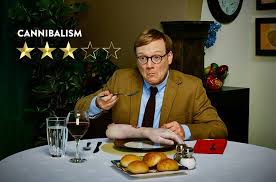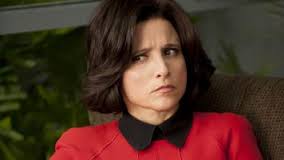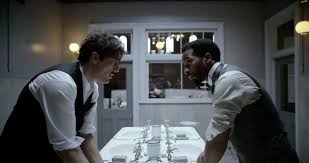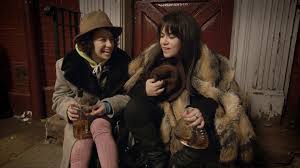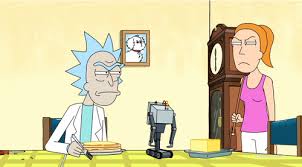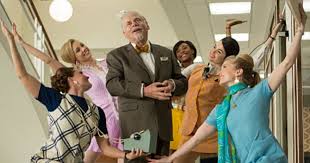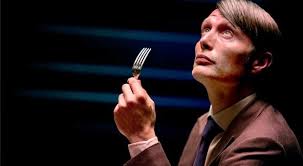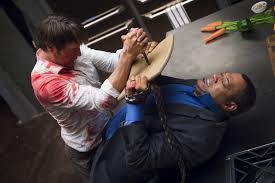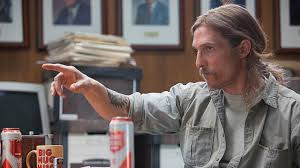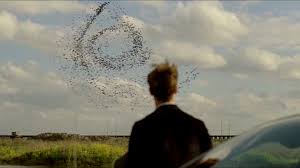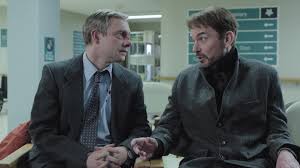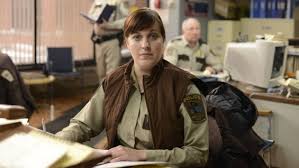10. (TIE) VEEP/REVIEW WITH FORREST MACNEIL (HBO/COMEDY CENTRAL)
The top of this list is going to be packed with dark (daaaark) dramas, but 2014 was a banner year for TV comedy. And our 10th place tie is between Veep and Review, two “sitcoms” that could respectively match True Detective for its despairing worldview and Game Of Thrones for the abuse it was willing to heap on its characters. Probably less needs to be said for Veep at this point, with its slew of Emmys and soforth, but even if we unfairly expect greatness by default from HBO or comic icon Julia Louis-Dreyfuss, it should be noted that they never once fail to deliver here. Profane, pointed but somehow non-partisan, with a supporting cast stuffed to the gills with absolute pros, the show just sings with each and every episode. Gary Cole is on the show, and he’s like the 6th funniest character; if you’re a Chud reader, you should understand how goddamn insane that is.
Review on the other hand flew under a lot more radars, which is just a tragedy, as it’s an absolutely brilliant showcase for Andy Daly’s deceptively dark comedic perspective. As a reviewer of general life experiences (anything from “Going To The Prom” to “Being A Racist” to the enigmatic “There All Is Aching”), Daly takes what would be a perfectly natural premise for a series of loosely-connected sketches and tints the comedy several shades blacker by imposing basic continuity on the proceedings. The result is that the show just gets funnier and funnier the further it tracks the utter disintegration of his signature affable-to-the-point-of-lameness straight man; Forrest divorces his wife for the sake of a review, and that isn’t even halfway through the season’s downward spiral. It would be unbearably awful to watch, if it wasn’t absolutely hilarious and he wasn’t doing every last bit of it entirely to himself.
.
That last bit is important, and is what might connect the comedic engines of these otherwise very different shows. Both build their jokes out of the idea that the characters are convinced that what they are doing is absolutely, vitally important, while the rest of the world only takes intermittent notice. Veep’s satire might seem more “important” because it’s about politics, but then the thrust of its cynicism lies in the assumption that these days politics only occasionally even aspires to anything more than theater. And Review offers a stealthy depiction of how convinced everyone in the internet age has become that recording our own opinions, no matter how mundane the topic, is the absolute apex of human endeavor. Maybe the former is a more important point overall, but for whatever mysterious reason, the latter resonates more with this amateur online TV critic.
Defining Moment(s): Selina nearly destroys the Special Relationship with a 2 day trip to London/Forrest passes an existential threshold by attempting to eat a truly upsetting amount of pancakes.
– Al Schwartz
9. THE KNICK (CINEMAX)
Steven Soderberg, one of the best and most interesting directors in the world, made a hospital show on TV. And not “made” as is often the case with big movie people, which generally amounts to at most directing a pilot. The Knick is as much a Soderberg joint as any of his movies, despite being a medical drama about a brilliant but drug-addicted doctor. And it’s on Cinemax. Pretty much all of that sounds like a joke. The Knick is no joke, though. It’s actually closer to Hell on Earth.
As the superhumanly conceited but sincere Dr. Thackery (Clive Owen) says early on, the characters are fighting death itself. But coming out of a period of barely understanding the most basic workings of disease and of the human body, they lack the tools and the methods to achieve their goals. Thackery’s solution is to push himself harder than humanly possible. When he can’t push any more he injects some cocaine and keeps going. His medical genius is a bullet, propelled by the cocaine and opium, aimed straight at death and like a bullet it will rip, tear and break anything soft that comes in its way.
But the series is more than a simple medical procedural or turn-of-the century freakshow. It’s not just medical science that is in a period of transition. We see a black doctor making fitful headway in a white hospital, but on the whole New York is still an impoverished cauldron boiling over with tension and suffering. It’s a world of unmarked graves for the poor, of back room abortions. A world of barriers based on gender, race or class, violently pushing back those who try to break through them. Like the difficult birthing procedure the show’s surgeons keep trying to perform to no avail, the new world’s coming is bloody and often lethal.
Defining Moment: Early 20th century mental health techniques.
– Stelios Xenidis
8. BROAD CITY (COMEDY CENTRAL)
One of the most talked about elements of Broad City was the way it was female driven from the top down. Beyond the imprint of producer Amy Poehler, the show was entirely carried by two stars in the making in Abbi Jacobsen and Ilana Glazer. And while it’s refreshing to see women allowed to play the kind of emotionally messy, occasionally gross or cruel comic leads usually reserved for men, such thoughts are quickly dispensed of when watching the show, which immediately crackles with levels of wit, daring and originality very few shows ever find. By the third episode, you don’t think in terms of how radical and progressive the show is, because you’re too busy marveling at the joke writing and performances.
Ostensibly another show about young singles in New York, Broad City transcends the tiredness of the basic concept early and often, swapping adeptly from a cartoonish reality to a thuddingly mundane one as best suits the joke. Despite being owned thoroughly by Jacobsen and Glazer, the show also packs a tremendously talented supporting cast, especially Cosby-ruiner Hannibal Buress, nailing every line given him with relaxed, sniper-like precision. It covers similar ground as HBO’s more-talked-about Girls, but never loses sight of being hilarious first, second and foremost. But the real takeaway is the leads; how clever, how endearing and how brave they are. This show feels like the heralding of a couple comic voices we’ll be hearing about for decades to come.
Defining Moment: The Scooby Doo like reveal of who shit in a pair of sneakers during the hurricane is a high comic crescendo.
– John Bernhard
7. RICK AND MORTY (ADULT SWIM)
Dan Harmon, the creator/spiritual leader of Community, had a pretty terrific year. Not only did that show regain its mojo and its heart following his unlikely un-firing, but his fledgling Adult Swim cartoon, Rick and Morty, turned out to be funniest, most original show on TV in its freshman foray. Presenting as a foul-mouthed take on Back To the Future’s Doc and Marty, the show quickly revealed a creative streak a mile wide, taking narrative twists into conceptual science fiction premises as outlandish as they were hilarious: Performing an Inception-style brain heist on Freddy Krueger, befriending a perfect clone of both Lincoln and Hitler (“Because I definitely think all men are created equal. But on the other hand…”), or transforming the entire world’s population, permanently, into fleshy abominations dubbed Cronenbergs, the show has a wickedly inventive imagination that simply doesn’t exist anywhere else on TV.
As strong as Community was (and, once again, is), I don’t know that the sitcom was ever as good a format for Harmon’s specific imagination as animation is turning out to be. Free of the constraints of physical reality, Rick and Morty could do literally anything week to week. It feels like a proper follow-up to Futurama in that respect, and also in its much less overt forays into sentiment. While Futurama was always happy to wear its heart on its sleeve, R&M plays it much closer to the vest, but is all the more effective when it finally breaks on through.
Defining Moment: There’s a hundred great moments in eleven scant episodes, but the one that probably speaks for all is the image of Rick and Morty, having destroyed all human life on Earth, soberly burying the corpses of the alternate earth Rick and Morty they’re replacing in a new dimension.
– John Bernhard
6. SILICON VALLEY (HBO)
Mike Judge finally found the perfect home for his unique blend of “ahead of its time” satire and lowbrow comedy in HBO’s surprisingly deft eight episode masterstroke. Silicon Valley is funny on so many levels, and its satire so acute that it instantly delivers on the uneven brilliance of Idiocracy and rough but seminal Office Space in a way that echoes not just his earlier work, but also complements the work Iannucci is doing concurrently on the network (a comparison that became impossible to avoid when the Veep crew visited their own version of Silicon Valley). Judiciously utilizing a wide net of comedians in the cast and finally having the good fortune of TJ Miller hitting at just the right time, Judge holds a warped mirror to the dotcom world, capturing both its absurdity and the so-huge-they-border-on-science-fiction numbers that make it alluring to hopeless nerd and vulture capitalist alike.
Everyone shines in the show, particularly Miller and the sadly now deceased Christopher Evan Welch. Welch’s Peter Gregory was the best new character of 2014 and unfortunately the actor’s death really puts a monkey wrench in the series’ best subplot. Luckily they still have a strong center in Thomas Middleditch (doing a more believable, less hateful version Sheldon Cooper) and the wonderfully low-key antagonism between Martin Starr and Kumail Nanjiani to fall back on. Few freshman shows are strong enough out of the gate to absorb the loss of such a key element, but Silicon Valley’s total package is a breezy blast and one of the shows that is positioned to really hold a mirror to a part of society ripe with fodder for many, many more laughs and episodes.
Defining Moment: The season culminating in the dick joke by which all future dick jokes will be measured (length and girth)
– Nick Nunziata
5. MAD MEN (AMC)
To quote a song that’s still a few years in Mad Men’s future, “you’re gonna make me lonesome when you go.” Despite the retro chic trends its inspired, this has never been a show to glamorize nostalgia, but with a half-season to go, I’m already in that headspace. Not only because the characters are some of the best in the history of the format (yes, even THAT one), but because after 7 years this show can still feel as formally experimental as it often does.
This half-season had one of the most narratively interesting inversions I’ve ever seen, pitting the audience’s desire to see Don return to work and assume command of his company with pitiable, childish behavior and then…well, more of the same. What should have been the cathartic moment that everyone was waiting for instead became a skin-crawling moment of supplication from a character who, frankly, needed the serving of humble pie. Yet despite knowing it needed to happen, the moment made me yell at my TV all the same. Don agrees to sober up and go back to work, which we know is the best thing for him and yet it felt like the ultimate sell-out. Because it was. Don’s behavior is cancerous, but it’s also what allows him to fly. The Pete Campbells of the world may be able to become their best self in California, but they’ll still get lapped by people like Don or Bob Benson. And their hairline will still recede.
But this was also a season that reset the clock, mending broken relationships in the week between episodes only to have them disintegrate by the end of the next hour. It’s one of the rare shows that uses that old TV trope to get to the stubborn, bad habits at the heart of real people and remind you that while times change, people are a little slower to catch up. And while that might sound like a difficult concept to dramatize, Mad Men gets it across with such ease and verve that it never becomes tedious. We didn’t get a drug freak-out episode like in years past, but Ginsberg offering of his “valve” to Peggy (following his HAL-9000 lip-reading) was an all-time weird and wonderful moment. Peggy became Don’s boss, Dawn and Shirley were the same person before Dawn became Joan (it’s a punishment) and the impossible-to-define Betty isn’t a stupid child…she speaks Italian.
Bravo.
Defining Moment: Burt Cooper reminding us that the best things in life are free.
– Miles Lemaire
4. HANNIBAL (NBC)
Is Art Guignol a real term? Should it be? It seems a show as unique as Hannibal would require its own special genre. Like Grand Guignol, the show is a parade of gloriously creepy monstrosities. There is more blood, gore, mutilation and pain in this show than other franchises could hope(/dread) to achieve. But there’s so much more to Hannibal than the mere trappings of horror; it’s torments never becomes a stale bore like Saw or a gory fart joke like The Human Centipede. There is an art to both the eponymous character and show’s madness. Creator Brian Fuller and Hannibal take us through murder and haute cuisine and elaborate games of psychological manipulation with the same unsettlingly acute attention to detail devoted to each. It’s this careful consideration that ensures that for all its horrible grandeur Hannibal never feels in danger of going too far and turning into a parody. It also helps that all the actors do such a great job of grounding their characters, even the overexposed title character. Seriously, just for managing to eclipse Anthony Hopkins in my mind’s eye, Mads Mikkelsen should receive some sort of acting medal.
We left the first season with Will soundly defeated by Hannibal. He’s imprisoned, framed for crimes he never committed, with his mind so broken he even doubts himself. In an ingenious reversal of the Clarice/Hannibal dynamic made so famous in the movies, it is he who provides his unique insight to the FBI from a cell. What ensues is probably the world’s highest stakes chess game. Plans are laid and foiled. Pawns are moved and sacrificed. Traps sprung and avoided. So often when such conflicts are presented (looking particularly hard at the terrible The Following here), the evil mastermind faces a bunch of bumbling boobs, the better to enable whatever plot twist needs to be hit next. In Hannibal, the game feels real, as the wits being matched are so similar in that up until the finale, ultimate loyalties lie in genuine doubt. And this makes the fight and its conclusion much more interesting and fun.
This is not a show I would recommend to everyone. And I’m not even bothered when people I recommend it to don’t like it. I’m just glad it exists. Because after all these years watching horror, finding something that still makes you stand up and really pay attention is priceless.
Defining Moment: The horrifying reveal of the “eye” in the silo
– Stelios Xenidis
3. TRUE DETECTIVE (HBO)
This was the TV event of the year, even if there are one or two shows ahead of it on this list. Not since Lost has a show sent its most devoted viewers down a rabbit hole of weird fiction and philosophy (“What is that, Nietzsche? Shut the fuck up!”), or felt quite so difficult to pin down. Even as creator Nic Pizzolatto promised us he wouldn’t dip into the realm of cosmic terror, it somehow felt possible right up until the end. Something about the potent and eerie cocktail of Robert W. Chambers references, oppressive mood and two of the best lead performances in any medium this year, held together by the bravura directorial vision of Cary Fukunaga, drove us all a little crazy for a minute.
Matthew McConaughey rightly stole the show as Detective Rust Cohle, swishing all of the best lines around his mouth like a fine wine and spitting them out like cheap tobacco. Cohle is a terrific addition to the canon of great fictional detectives on the page, but McConaughey inverted his relaxed, effortless charm into something twitchy and paranoiac, leaving room to question the established intelligence (and sanity) of the character. He’s helped by a great sparring partner in Woody Harrelson’s Marty Hart, a no-less-intelligent cop who grounded the spaciest of intellectual dalliances with a hearty catalogue of variations on “shut the fuck up.” But when Rust is allowed to fly, he’s a meme generator unto himself, extolling the flat, circular nature of time and carving little beercan-people-diagram-things and somehow crafting it into the year’s most iconic TV scene in the process.
As we saw later this year with Serial, audiences are ready to have a mystery story fed to them piecemeal, but more-so when they could sift through the evidence in their week-long wait between episodes. As much as people liked the show, it seems they liked what it did for their thought-life even more. Only time will tell, but this may be The Velvet Underground of television, getting everyone who saw it to start a band of their own. That’d certainly make a good case for the light winning and more than enough reason to earn it a spot near the top of this list.
Defining Moment: The epic tracking shot from “Who Goes There” is difficult to ignore, but when Rust and Marty first get a look at Reggie Ledoux in his gas mask, the stakes of the show changed drastically.
– Miles Lemaire
2. FARGO (FX)
True Detective got all the hype (and Miles speaks eloquently for its quality and legacy above), but for my money it was only the 2nd best show about determined cops hunting a confounding, nigh-supernatural evil over an extended timeframe in a very exact, lived-in setting. Noah Hawley took on a seemingly-impossible task of not just remaking but expanding the most highly-regarded film in the ouvre of the greatest American filmmakers (whatever, I’ll stand by it). And he knocked it straight out of the gosh darn park, don’tcha know, with sharp, audacious writing that matched the Coens for unpredictable violence and understated, dark humor. Also outdoing itself is a tremendous cast that has Billy Bob Thornton and Martin Freeman up front and a bench stacked with the likes of Bob Odenkirk, Keith Carradine and Adam Goldberg. But the standout has to be newcomer Alison Tohlman, bringing warmth and humanity to the dark and chilly landscape in every scene, and generally doing Frances McDormand proud. There are at least 3 things wrong with the fact that she did not win the Best Supporting Actress In A Miniseries Or Movie Emmy for which she was nominated.
.
Fargo was the year’s biggest and best surprise, and did a lot to buoy FX’s reputation as a font of quality adult drama during a time when an aging Justified took its first appreciable dip in quality (such that it went from a top 5 finisher last year to not even garnering a single vote for this list), Sons Of Anarchy completed its death-spiral into morbid, incoherent obesity, and The Strain mostly ate paste in the corner. Next year it won’t have the element of surprise on its side, but it will have plenty of goodwill to go with a new cast that already includes Kirsten Dunst and Jesse Plemons. And hopefully the same sense of place, of humor, and expertly-deployed violence that incongruously made this frequently sickening series one of the year’s most purely pleasurable viewing experiences.
Defining Moment: Billy Bob sits down for a horrifically tense piece of pie at Carradine’s diner.
– Al Schwartz
1. GAME OF THRONES (HBO)
Given this site’s sensibilities, it’s a safe assumption that Game Of Thrones will hold down this top spot for the next few years. HBO’s lush, twisty, really just incredibly violent epic is simultaneously one of the most harrowing and most compulsively watchable experiences the small screen has to offer, and this year it crescendoed with another series of triumphs and (mostly) tragedies, and topped it off with several of the best action sequences the show has done yet, with a pair of momentous duels, a skeleton fight straight out of Jason And The Argonauts, and the long-promised (and just plain long) siege of Castle Black. The cast remained as deep and perfect as ever, with sexy newcomer Pedro Pascal bringing new flavor to King’s Landing, Dinklage continuing to astound at every turn, and Kit Harrington finally turning Jon Snow into a hero worth rooting for, after several years of staring kind of vaguely at things.
The only real threat to Game’s continued supremacy is that it’s continued sprawl always threatens to get away from itself, as this year saw the people of Dorne and Braavos enter the already-crowded mix in a big way, as well as the prominent return of the Eyrie, and new cities for the khaleesi to mill around in until the main plot is ready for her. But having source material is a boon in this regard (for at least as long as George RR Martin can keep ahead of the production schedule), as it ensures that nothing in the far-flung corners of the narrative is introduced without purpose. And the flip side of the sprawl means that even if you don’t like Stannis, in a scene or two you’ll be with Dany. And if you don’t like her, there will be some action at the Wall just after. And if that’s not your speed, we’ll be back in King’s Landing in a moment. And if you don’t like what’s going on there, you have serious problems, man, because everything in the capital (give or take a queasy sex scene) is awesome.
We’re looking forward to what all of these shows do next year, whether their triumphant swan songs like Mad Men, anticipated sophomore efforts like Rick and Morty, or big question marks like Fargo and True Detective. But let’s be honest; none of those are going to hold a candle to the type of spoiler-phobic circles we’re going to be talking ourselves in for the next few months, as we chew fingernails down to nubs waiting for our return to Westeros. There are still a great many men in that fictional continent, after all, and the show has taught us that sooner or later, all of them must die. I’m kind of terrified to see how, but I definitely can’t wait to see it either.
Defining Moment: The Mountain and The Viper. Or Tyrion’s trial. Or the king’s wedding feast. Or the boys of the Night’s Watch facing down a rampaging giant. Or the Hound eating every chicken. Look, it’s a big ass show, so it’s hard to narrow it down to one.
– Al Schwartz
